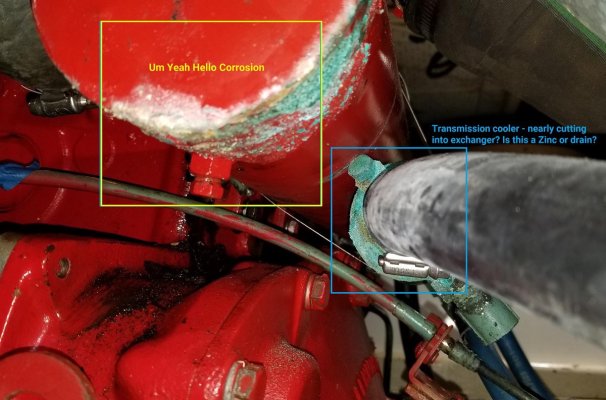Hi,
I'm looking at the Heat Exchanger on a Lehman in my GB32, and found an area that didn't get picked up by the original survey, nor by my wandering eyes till recently. It's very corroded and I'm looking for a little advice:
- At the port-side of the exchanger, it's moist and very corroded, and has a small dent or almost-hole (see photo with circle) -- I'm not touching it much because it feels extremely fragile and ready to disintegrate if i look at it wrong. Appears to be end-of-life, replacement needed, but wanted a gut check?
(Interesting to note there's no removable end-cap on this side. I see American Diesel's do and others. Seems preferable to me.)
- On the Starboard side, mine has a different end-cap than typical, with a hose coming out to my stuffing box. I've checked with SeaFlow who advised that this will probably be reusable/screw-on to a their new replacement exchanger. I don't know exactly the flow inside these things -- It appears it's Seawater that would flow to/from the stuffingbox - but I question if there is anything "special" about the internals of my existing exchanger that would be different/incompatible with a new standard replacement unit?
- Finally looking at the Transmission cooler (green) - there is some bolt sticking up that nearly cuts into the damn heatexchanger, what's that about?! And does it appear, looking at the corrosion, that I should replace this at the same time?
Thanks for your thoughts here - this community is amazing with shared knowledge and experiences!
I'm looking at the Heat Exchanger on a Lehman in my GB32, and found an area that didn't get picked up by the original survey, nor by my wandering eyes till recently. It's very corroded and I'm looking for a little advice:
- At the port-side of the exchanger, it's moist and very corroded, and has a small dent or almost-hole (see photo with circle) -- I'm not touching it much because it feels extremely fragile and ready to disintegrate if i look at it wrong. Appears to be end-of-life, replacement needed, but wanted a gut check?
(Interesting to note there's no removable end-cap on this side. I see American Diesel's do and others. Seems preferable to me.)
- On the Starboard side, mine has a different end-cap than typical, with a hose coming out to my stuffing box. I've checked with SeaFlow who advised that this will probably be reusable/screw-on to a their new replacement exchanger. I don't know exactly the flow inside these things -- It appears it's Seawater that would flow to/from the stuffingbox - but I question if there is anything "special" about the internals of my existing exchanger that would be different/incompatible with a new standard replacement unit?
- Finally looking at the Transmission cooler (green) - there is some bolt sticking up that nearly cuts into the damn heatexchanger, what's that about?! And does it appear, looking at the corrosion, that I should replace this at the same time?
Thanks for your thoughts here - this community is amazing with shared knowledge and experiences!




